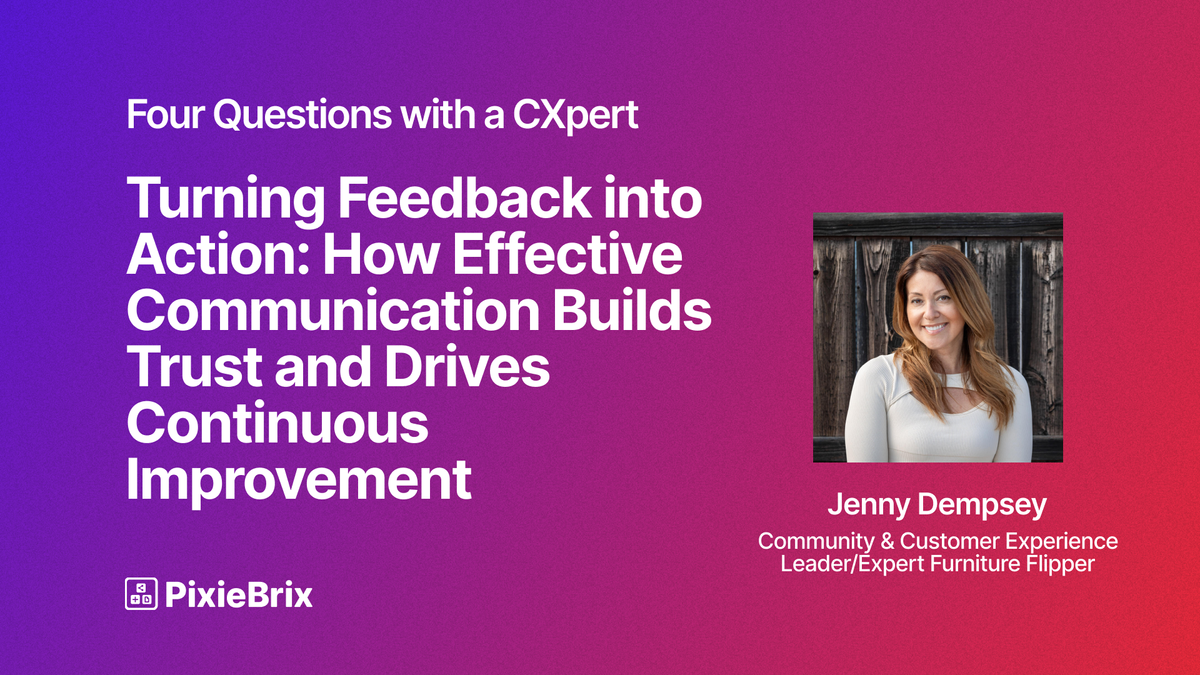Communicating Customer Feedback and Building Thriving Communities: A Dual Approach to Customer Experience
Building strong relationships with customers starts with truly listening and acting on their feedback.

Effectively communicating with customers about their feedback and ensuring continuous improvement is crucial for building trust. By actively following up on suggestions and using tools like ticketing systems to track updates, we can show customers that their input directly influences our actions.
For this edition of 4 Questions with a CXpert, we sat down with Community & Customer Experience Leader/Expert Furniture Flipper Jenny Dempsey to learn about the importance of creating and engaging in thriving online communities to help foster brand loyalty by addressing customer needs and encouraging meaningful interactions.
We also got some insider tips on furniture flipping.
How do you communicate back to customers that their feedback has been heard and acted upon? What processes do you have in place to ensure continuous improvement based on customer feedback?
Jenny Dempsey: When customers give feedback, I make sure to let them know I’ve heard them and are taking action. For instance, if a customer suggests updating content on our website, I let them know that I understand the importance and that I’m working on it. I own this, even though I’m personally not making the update. Later, when our marketing team makes the update, I follow up with the customer again with a link to the page, a picture, a screenshare, whatever it is to show them we've acted on their feedback. Because sometimes updates take time and there’s no way to remember everything you need to follow up on, I use a reminder in the ticketing system that reopens the ticket and reminds me to follow up with customers at specific times. This helps me not only tell customers their feedback matters but also show them how we're making changes based on what they've shared. This approach builds trust and lets customers see their input directly impacts our improvements.
Customer communities can be a powerful tool for fostering brand loyalty and advocacy. How would you approach building and engaging a thriving online community for your customers?
Jenny Dempsey: Creating a thriving online community for customers starts with understanding their needs and the problems they face. It's not just about having a space to chat; it's about providing a solution that adds real value to their lives. For example, if customers struggle with troubleshooting product issues, the community can become a go-to resource for sharing tips, troubleshooting guides, and direct support from experts. To build engagement, it's crucial to meet customers where they already spend their time. If they're active on social media platforms like Facebook or Instagram, you can leverage these channels to introduce and connect them to our community. This approach makes it easier for them to join without needing to learn a completely new platform from scratch. Another key aspect is making the community feel like their own space. Encouraging discussions, highlighting user-generated content, and hosting live Q&A sessions with product teams can create a sense of belonging and ownership among members. Lastly, continuous feedback loops are essential. Regularly soliciting and acting on feedback ensures the community evolves in ways that meet the changing needs and preferences of its members. This shows our commitment to their experience and fosters deeper loyalty and advocacy over time.
A recent Forbes article titled “Thank You For Not Calling! Agents Are On The Verge of Burnout” quoted Shep Hyken as saying “⅓ of consumers admit to yelling at an agent while ¼ admitted to cussing one out.” What programs or initiatives would you implement to help contact center agents manage stress and avoid burnout? How do you ensure these programs are effective and accessible to all agents?
Jenny Dempsey: Wow, that Forbes article really hits home about the challenges agents face in contact centers. It's tough out there, and it's clear we need to prioritize our agents' well-being. First off, I'd focus on creating a supportive environment where agents feel heard and valued. Regular check-ins with team leads or managers can provide a safe space for agents to discuss stressors and brainstorm solutions. Sometimes, just knowing someone's got your back can make a huge difference. Next, training is key. Equip agents with tools and resources to quickly get the answers they need to handle difficult interactions calmly and effectively. Keep the knowledge base updated with answers, for example. Training wise, role-playing sessions can help them practice handling tough calls, so they feel more confident and less stressed when faced with irate customers. We shouldn't stop there, though. Implementing flexible scheduling options allows agents to better manage their work-life balance. Whether it's offering compressed workweeks or allowing remote work, giving agents more control over their schedules can reduce burnout. Lastly, feedback loops are crucial. Regularly surveying agents about their stress levels and the effectiveness of our programs ensures we're on the right track. And let's make sure these programs are accessible to everyone—whether they're on-site or working remotely, everyone deserves the same support. And - show them that you’re actually listening and make changes that they suggest. Ultimately, it's about creating a culture that prioritizes mental health and empowers agents to do their best work. When our agents feel supported, they can provide exceptional service without feeling overwhelmed.
Where do you typically find furniture pieces to flip? How do you determine if a piece of furniture is worth purchasing for a flip?
Jenny Dempsey: Oh, I find furniture pieces in all sorts of places—sometimes in the trash, alleys, or just left on the curb. It's like a treasure hunt! My friends even keep an eye out for me and send texts when they spot something they think I could work my magic on. People also bring me their old furniture that they're getting rid of, or they know someone who is. Now, figuring out if a piece is worth flipping has been a journey. At first, I'd flip anything and everything I found, big or small. Some pieces sold like hotcakes, while others just sat there. That's when I realized the importance of market research and trial and error. I started keeping track of which pieces were popular with clients. Dressers are a hit—they sell like crazy. Dining tables are another favorite. These insights helped me focus my efforts on pieces with a higher chance of selling, making the time and effort worth it. It's all about finding those diamonds in the rough, keeping them out of the landfill and turning them into something beautiful and profitable!



